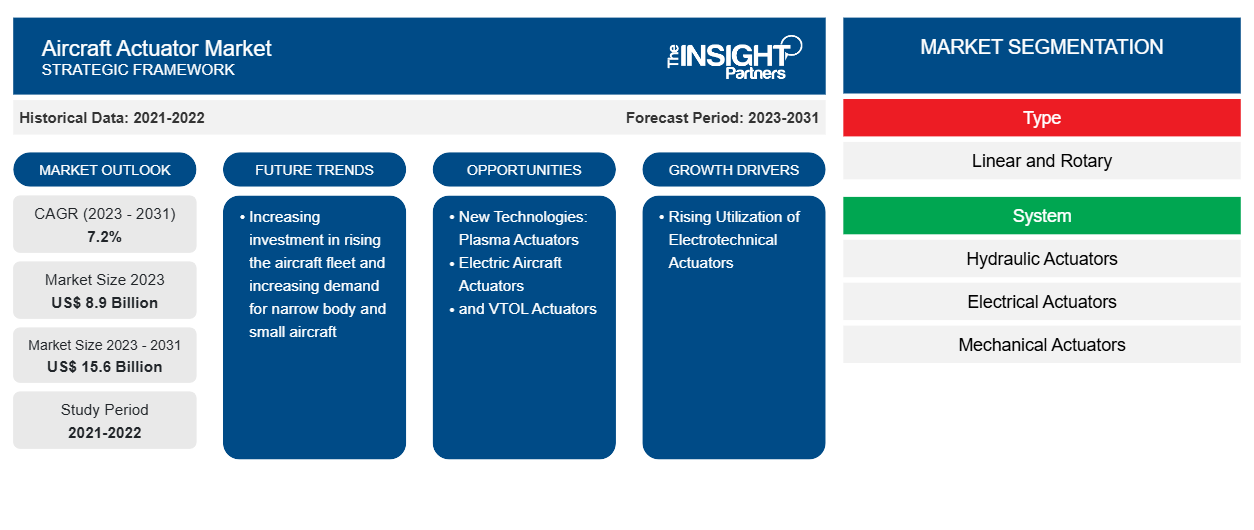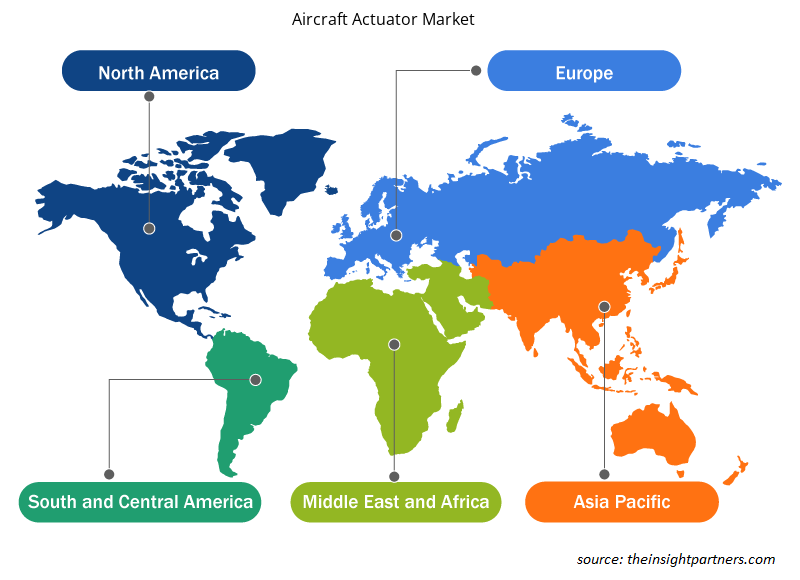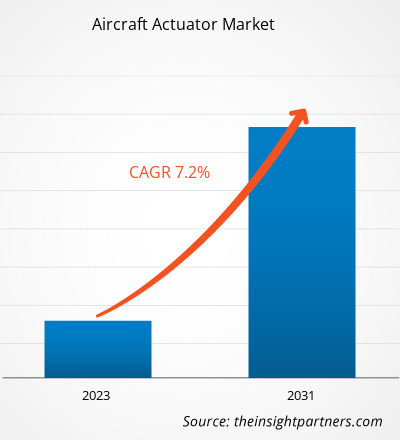The aircraft actuator market size is projected to reach US$ 15.6 billion by 2031 from US$ 8.9 billion in 2023. The market is expected to register a CAGR of 7.2% in 2023–2031. Increasing investment in raising the aircraft fleet and increasing demand for narrow-body and small aircraft are among the key factors driving the aircraft actuator market.
Aircraft Actuator Market Analysis
The growth of the aircraft actuators market is majorly driven by significant investments in advanced technologies in the aviation industry. Over the past twenty years, the aviation (commercial and military) industry has grown signifacntly. The rate of technological transformation has been outstanding, which has increased the demand for various products and services. There is an increase in the adoption of aircraft actuator solutions in commercial aircraft owing to the rise in demand for improving flight control systems and landing gears. The increasing number of aircraft accidents and improving regulatory standards of safety have highlighted the importance of aircraft actuators. To improve the performance level, aircraft are adopting advanced electromechanical actuation systems. Electromechanical actuators are gaining considerable growth in the market as aircraft manufacturers are moving toward the integration of more electrical systems in aircraft. Further, advancements in aircraft control systems, such as digitalization and Internet of Things (IoT) connectivity, are supporting the market growth.
Aircraft Actuator Market Overview
The aircraft actuator industry is continuously evolving with innovations in product offerings to provide smaller, lighter, and cost-effective actuation systems. The rising demand for electromechanical actuators to enhance the actuation processes is propelling the market growth. The advent of electric aircraft is creating a new opportunity for the market players to focus on developing lighter, smaller, and more efficient aircraft actuators. Further, increasing demand for small and narrow-body aircraft fleets from developing as well as developed nations propels the market growth. Increasing electrification in aircraft systems with hybrid formulation using mechanical and hydraulic systems is boosting the growth of the aircraft actuators market.
Customize This Report To Suit Your Requirement
You will get customization on any report - free of charge - including parts of this report, or country-level analysis, Excel Data pack, as well as avail great offers and discounts for start-ups & universities
Aircraft Actuator Market: Strategic Insights

- Get Top Key Market Trends of this report.This FREE sample will include data analysis, ranging from market trends to estimates and forecasts.
You will get customization on any report - free of charge - including parts of this report, or country-level analysis, Excel Data pack, as well as avail great offers and discounts for start-ups & universities
Aircraft Actuator Market: Strategic Insights

- Get Top Key Market Trends of this report.This FREE sample will include data analysis, ranging from market trends to estimates and forecasts.
Aircraft Actuator Market Drivers and Opportunities
Rising Utilization of Electrotechnical Actuators
Aircraft flight control systems are shifting from bulky, heavy, and leaky hydraulic systems to electric autonomous systems. The advancements in electromechanical (EM) actuators, such as reliability, compact nature, lightweight, and cost-efficiency, are mounting its adoption in aircraft. Commercial and military aircraft fleets are looking for advanced systems that are lighter in weight to enhance fuel efficiency. Actuators in aircraft are used in the functionality of landing gear, slats and spoilers, seats, flaps, positioning engine inlet guide vanes, rudder, ailerons, and opening and closing cargo or weapon bay doors, among others. Since aircraft OEMs are increasingly emphasizing lightweight aircraft models, electromechanical actuators are attracting OEMs in the current scenario, which is catalyzing the aircraft actuators market. Another reason for the increasing adoption of electromechanical actuators is the paradigm shift of the aerospace industry toward electric aircraft, which is obsoleting the hydraulic, pneumatic, and mechanical systems and is increasing the adoption of electric actuation systems. This trend is generating substantial demand for electrical actuators, which is ultimately boosting the aircraft actuators market.
New Technologies: Plasma Actuators, Electric Aircraft Actuators, and VTOL Actuators
Aircraft actuators industry has evolved from pneumatic actuator systems and hydraulic actuator systems to electric actuator systems. As the aircraft fleet is shifting toward clean energy sources, the adoption of electric energy is on the surge in the aviation industry to reduce emissions. The advent of electric aircraft is creating a new trend of electric actuators in the market. For instance, in December 2020, Curtiss-Wright company received the order to provide primary flight control actuation technology for Alice's all-electric commuter aircraft. The company is offering a commercial-off-the-shelf (COTS) EMA design that is lighter, cost-effective and reduces the program risk. Further, hydraulic and pneumatic systems are bulkier, which increases the weight and results in increased fuel consumption. Hence, the aircraft industry is using lightweight electric actuators to reduce additional fuel consumption caused by heavy systems.
Aircraft Actuator Market Report Segmentation Analysis
Key segments that contributed to the derivation of the aircraft actuator market analysis are type, system, and end user.
- Based on type, the aircraft actuator market has been divided into linear and rotary. The linear segment held a larger market share in 2023.
- Based on the system, the aircraft actuator market has been divided into hydraulic actuators, electrical actuators, mechanical actuators, and pneumatic actuators. The pneumatic actuators segment held a larger market share in 2023.
- On the basis of end user, the market has been segmented into commercial aircraft and military aircraft. The commercial aircraft segment held the largest market share in 2023.
Aircraft Actuator Market Share Analysis by Geography
The geographic scope of the aircraft actuator market report is mainly divided into five regions: North America, Europe, Asia Pacific, Middle East & Africa, and South America.
North America has dominated the aircraft actuator market in 2023. The North America region includes the US, Canada, and Mexico. The aerospace industry in North America has matured due to the presence of a large number of aircraft manufacturers, advanced actuator technology providers, and a skilled workforce. There is a tremendous demand for new control systems in the region as end users such as military and commercial aircraft manufacturers are well aware of newer technologies. Owing to this, the adoption of electric and hydraulic aircraft actuator solutions in commercial aircraft is high and witnessing increased integration in new narrow-body aircraft developed by aircraft manufacturers. The commercial aerospace sector in North America is majorly dominated by Boeing, which is also integrating a wide range of actuators in its B787 and B777 models for enhanced flight control.
Aircraft Actuator Market Regional Insights
The regional trends and factors influencing the Aircraft Actuator Market throughout the forecast period have been thoroughly explained by the analysts at Insight Partners. This section also discusses Aircraft Actuator Market segments and geography across North America, Europe, Asia Pacific, Middle East and Africa, and South and Central America.

- Get the Regional Specific Data for Aircraft Actuator Market
Aircraft Actuator Market Report Scope
| Report Attribute | Details |
|---|---|
| Market size in 2023 | US$ 8.9 Billion |
| Market Size by 2031 | US$ 15.6 Billion |
| Global CAGR (2023 - 2031) | 7.2% |
| Historical Data | 2021-2022 |
| Forecast period | 2023-2031 |
| Segments Covered |
By Type
|
| Regions and Countries Covered | North America
|
| Market leaders and key company profiles |
Aircraft Actuator Market Players Density: Understanding Its Impact on Business Dynamics
The Aircraft Actuator Market is growing rapidly, driven by increasing end-user demand due to factors such as evolving consumer preferences, technological advancements, and greater awareness of the product's benefits. As demand rises, businesses are expanding their offerings, innovating to meet consumer needs, and capitalizing on emerging trends, which further fuels market growth.
Market players density refers to the distribution of firms or companies operating within a particular market or industry. It indicates how many competitors (market players) are present in a given market space relative to its size or total market value.
Major Companies operating in the Aircraft Actuator Market are:
- Collins Aerospace
- Cutiss-Wright Corporation
- Eaton Corporation Plc
- Honeywell International Inc.
- Meggitt PLC
- Moog Inc.
Disclaimer: The companies listed above are not ranked in any particular order.

- Get the Aircraft Actuator Market top key players overview
Aircraft Actuator Market News and Recent Developments
The aircraft actuator market is evaluated by gathering qualitative and quantitative data post primary and secondary research, which includes important corporate publications, association data, and databases. The following is a list of developments in the market for aircraft actuator market and strategies:
- In June 2023, Supernal (an advanced air mobility company) partnered with UMBRAGROUP. Through this partnership, UMBRAGROUP will supply actuators and motor control electronics in deploying system architecture for Supernal’s future vehicles.
- In July 2022, Honeywell International, Inc. signed an agreement with Archer Aviation Inc. Through this agreement, Honeywell will supply actuators and climate system technology for Archer’s production aircraft.
Aircraft Actuator Market Report Coverage and Deliverables
The “Aircraft Actuator Market Size and Forecast (2021–2031)” report provides a detailed market analysis of the covering below areas:
- Market size and forecast at global, regional, & country levels for all the key market segments covered under the scope
- Market dynamics such as drivers, restraints, and key opportunities
- Key future trends
- Detailed Porter’s Five Forces analysis
- Global and regional market analysis covering key market trends, major players, regulations, and recent market developments
- Industry landscape and competition analysis covering market concentration, heat map analysis, prominent players, and recent developments
- Detailed company profiles with SWOT analysis
- Historical Analysis (2 Years), Base Year, Forecast (7 Years) with CAGR
- PEST and SWOT Analysis
- Market Size Value / Volume - Global, Regional, Country
- Industry and Competitive Landscape
- Excel Dataset
- Aircraft MRO Market
- Helicopter Hoists Winches and Hooks Market
- Fixed-Base Operator Market
- Aerospace Fasteners Market
- Aerospace Stainless Steel And Superalloy Fasteners Market
- Aircraft Floor Panel Market
- Military Optronics Surveillance and Sighting Systems Market
- Smoke Grenade Market
- Airport Runway FOD Detection Systems Market
- Artillery Systems Market
Testimonials
I wish to appreciate your support and the professionalism you displayed in the course of attending to my request for information regarding to infectious disease IVD market in Nigeria. I appreciate your patience, your guidance, and the fact that you were willing to offer a discount, which eventually made it possible for us to close a deal. I look forward to engaging The Insight Partners in the future, all thanks to the impression you have created in me as a result of this first encounter.
DR CHIJIOKE ONYIA, MANAGING DIRECTOR, PineCrest Healthcare Ltd.The Insight Partners delivered insightful, well-structured market research with strong domain expertise. Their team was professional and responsive throughout. The user-friendly website made accessing industry reports seamless. We highly recommend them for reliable, high-quality research services
Yukihiko Adachi CEO, Deep Blue, LLC.Reason to Buy
- Informed Decision-Making
- Understanding Market Dynamics
- Competitive Analysis
- Customer Insights
- Market Forecasts
- Risk Mitigation
- Strategic Planning
- Investment Justification
- Identifying Emerging Markets
- Enhancing Marketing Strategies
- Boosting Operational Efficiency
- Tracking Industry Innovations
- Aligning with Regulatory Trends
Yes! We provide a free sample of the report, which includes Report Scope (Table of Contents), report structure, and selected insights to help you assess the value of the full report. Please click on the "Download Sample" button or contact us to receive your copy.
Absolutely — analyst assistance is part of the package. You can connect with our analyst post-purchase to clarify report insights, methodology or discuss how the findings apply to your business needs.
Once your order is successfully placed, you will receive a confirmation email along with your invoice.
• For published reports: You’ll receive access to the report within 4–6 working hours via a secured email sent to your email.
• For upcoming reports: Your order will be recorded as a pre-booking. Our team will share the estimated release date and keep you informed of any updates. As soon as the report is published, it will be delivered to your registered email.
We offer customization options to align the report with your specific objectives. Whether you need deeper insights into a particular region, industry segment, competitor analysis, or data cut, our research team can tailor the report accordingly. Please share your requirements with us, and we’ll be happy to provide a customized proposal or scope.
The report is available in either PDF format or as an Excel dataset, depending on the license you choose.
The PDF version provides the full analysis and visuals in a ready-to-read format. The Excel dataset includes all underlying data tables for easy manipulation and further analysis.
Please review the license options at checkout or contact us to confirm which formats are included with your purchase.
Our payment process is fully secure and PCI-DSS compliant.
We use trusted and encrypted payment gateways to ensure that all transactions are protected with industry-standard SSL encryption. Your payment details are never stored on our servers and are handled securely by certified third-party processors.
You can make your purchase with confidence, knowing your personal and financial information is safe with us.
Yes, we do offer special pricing for bulk purchases.
If you're interested in purchasing multiple reports, we’re happy to provide a customized bundle offer or volume-based discount tailored to your needs. Please contact our sales team with the list of reports you’re considering, and we’ll share a personalized quote.
Yes, absolutely.
Our team is available to help you make an informed decision. Whether you have questions about the report’s scope, methodology, customization options, or which license suits you best, we’re here to assist. Please reach out to us at sales@theinsightpartners.com, and one of our representatives will get in touch promptly.
Yes, a billing invoice will be automatically generated and sent to your registered email upon successful completion of your purchase.
If you need the invoice in a specific format or require additional details (such as company name, GST, or VAT information), feel free to contact us, and we’ll be happy to assist.
Yes, certainly.
If you encounter any difficulties accessing or receiving your report, our support team is ready to assist you. Simply reach out to us via email or live chat with your order information, and we’ll ensure the issue is resolved quickly so you can access your report without interruption.





















 Get Free Sample For
Get Free Sample For